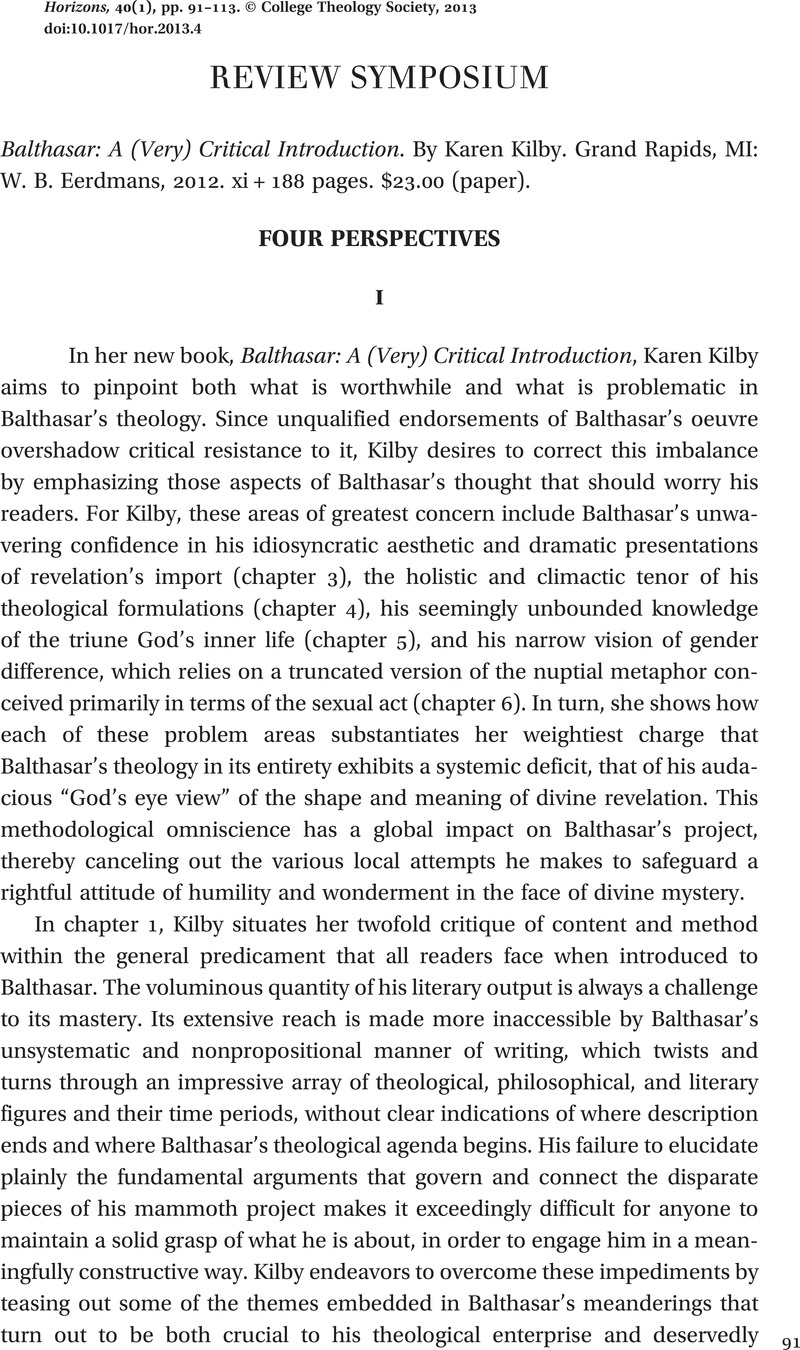No CrossRef data available.
Article contents
Balthasar: A (Very) Critical Introduction. Four Perspectives – III - Balthasar: A (Very) Critical Introduction. By Karen Kilby. Grand Rapids, MI: W. B. Eerdmans, 2012. xi + 188 pages. $23.00 (paper).
Published online by Cambridge University Press: 31 July 2013
Abstract

- Type
- Review Symposium
- Information
- Copyright
- Copyright © College Theology Society 2013
References
1 von Balthasar, Hans Urs, “Rede an der Verleihung des Mozart-Preises,” in Guerriero, Elio, Hans Urs von Balthasar: Eine Monographie (Einsiedeln: Johannes Verlag, 1993), 423Google Scholar. He even complicates the metaphor: he presents his trilogy as a garden with many statues with God as its center.
2 von Balthasar, Hans Urs, The Glory of the Lord: A Theological Aesthetics, vol. 5, The Realm of Metaphysics in the Modern Age, trans. Davies, Oliver et al. (Edinburgh: T&T Clark, 1991), 609–10.Google Scholar
3 Ibid., 513.
4 von Balthasar, Hans Urs, The Glory of the Lord: A Theological Aesthetics, vol. 2, Studies in Theological Style: Clerical Styles, trans. Louth, Andrew, McDonagh, Francis, and McNeil, Brian (Edinburgh: T&T Clark, 1984), 354.Google Scholar
5 Ibid., 128.
6 Ibid., 127.
7 There are other more problematic features in Balthasar's theological aesthetics that may have a negative influence on Balthasar's Theo-Drama. See Dalzell, Thomas, The Dramatic Encounter of Divine and Human Freedom in the Theology of Hans Urs von Balthasar, Studies in the Intercultural History of Christianity 105 (Bern: Lang, 1997).Google Scholar
8 See von Balthasar, Hans Urs, Theo-Drama: Theological Dramatic Theory, vol. 4, The Action, trans. Harrison, Graham (San Francisco: Ignatius, 1994), 383–88Google Scholar (“The Paradox of Christian Discipleship”).
9 See Papanikolaou, Aristotle, “Person, Kenosis, and Abuse: Hans Urs von Balthasar and Feminist Theologies in Conversation,” Modern Theology 19 (2003): 41–65CrossRefGoogle Scholar; on Balthasar and Ignacio Ellacuría: De Schrijver, Georges, Recent Theological Debates in Europe: Their Impact on Inter-Religious Dialogue (Bangalore: Dharmaram Publications, 2004), 263–338.Google Scholar
10 Numquam duo, semper tres, “Never two, always three”: a traditional Latin motto warning youngsters not to be alone with another person, in order to prevent the development of “particular friendships.”
12 See, e.g., Todd Walatka, “The Opening of the Political: Grounding Political Action in Hans Urs Von Balthasar's Theodramatic Christology through an Engagement with the Christology of Jon Sobrino” (PhD diss., University of Notre Dame, 2011).
13 See de Maeseneer, Yves, “The Art of Disappearing: Religion and Aestheticization,” in The New Visibility of Religion: Studies in Religion and Cultural Hermeneutics, ed. Ward, Graham and Hoelzl, Michael, Studies in Religion and Political Culture 1 (London: Continuum, 2008), 99–116.Google Scholar




